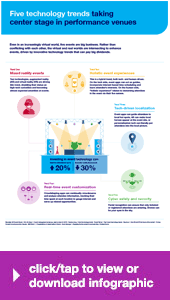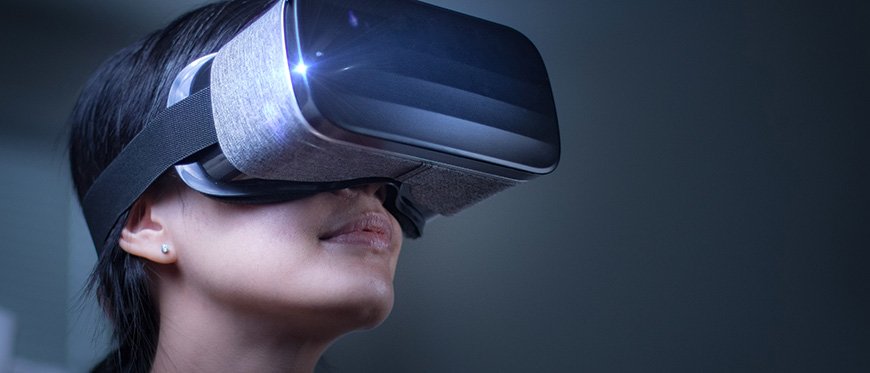Even in an increasingly virtual world, live events are big business, with US concert and event revenues projected at $31 billion for 2018 (not including franchise sporting events or business conferences). Rather than conflicting with each other, the virtual and real worlds are intersecting to enhance events, driven by innovative technology trends that can pay big dividends. Research shows that investing in event technology, from planning and management tools to experiential enhancements, can improve attendance up to 20%, while decreasing costs as much as 30%.
Here’s a brief overview of five key trends in event technology:
Trend One: Mixed reality events
 Reality comes in many forms these days, and successful events are mixing real/analog experiences with digital/virtual encounters. Two technologies, augmented reality (AR) and virtual reality (VR) are driving this trend, shedding their status as high-tech curiosities and becoming almost expected amenities at events. In 2017, the mega-festival Coachella gave attendees an AR/VR app as part of its pre-festival welcome kit, enabling them to begin experiencing the festival even before arrival. Other events import presenters from around the world, as 3D projections. Soon they may even feature speakers or performers from throughout history, digitally revived and realistically interacting, via the combination of artificial intelligence (AI), VR and other technologies.
Reality comes in many forms these days, and successful events are mixing real/analog experiences with digital/virtual encounters. Two technologies, augmented reality (AR) and virtual reality (VR) are driving this trend, shedding their status as high-tech curiosities and becoming almost expected amenities at events. In 2017, the mega-festival Coachella gave attendees an AR/VR app as part of its pre-festival welcome kit, enabling them to begin experiencing the festival even before arrival. Other events import presenters from around the world, as 3D projections. Soon they may even feature speakers or performers from throughout history, digitally revived and realistically interacting, via the combination of artificial intelligence (AI), VR and other technologies.
This sort of at-event immersion and experiential expansion will become even more important as technology also empowers people to experience the event without actually attending. Oculus, best known for its consumer-market VR headsets, has an event division that allows people to remotely attend live sporting and entertainment events – and not just watching, but immersing themselves in the events, walking through the crowds, getting back stage, being part of the excitement.
Trend Two: Holistic event experiences
This is a hybrid trend, both tech- and human-driven. On the tech side, event apps at a minimum can act as event guides, ensuring that attendees find the moments, and locations, most relevant to their interests. They can incorporate interest-based time scheduling, to make sure attendees don’t miss anything; proximity-sensing, to alert attendees when they are near a relevant event; and AI, to learn what has been most interesting to an attendee as the event progresses and then prioritize recommendations for the remaining time.
On the human side, “holistic experience” relates to immersing attendees in the event via their five senses. From the visual excitement of projection mapping (which can throw an image on to any surface or item, such as a truck or building) to personalized, app-based audio tours, to custom, one-of-a-kind scents, to simple tastings of special food and drink treats––the five senses can be employed to make any event more memorable.
Trend Three: Tech-driven localization
Just as locavores are transforming the food industry with their commitment to “eat local,” so, too, are authenticity-hungry attendees transforming live events. Part of the localization movement simply involves better planning, for the inclusion of unique local venues, and opportunities to experience local culture. But it can also be tech enhanced, with event apps that guide attendees to local hot spots, AR that makes local heroes appear at the event site, or personalization tech that literally puts attendees into the local picture (and then automatically posts it to their favorite social platforms).
Trend Four: Real-time event customization
That personalized update of the old event photo booth concept is just one of many opportunities to personalize and customize the event experience, both for the individual attendee and the entire crowd. Crowdshaping apps can continually crowdsource and analyze attendee information, tracking their time spent at each location to gauge interest and serve up related opportunities. Biometric monitoring can let a facility know when people are getting too hot, so that the temperature can be adjusted. And projection mapping, with its ability to project and “wrap” images around virtually any object, can instantly modify a space to any theme, without physical alterations.
Trend Five: Cyber safety and security
Events attract more than entertainment seekers or industry professionals; as locations with large crowds (and valuable databases) they can also attract trouble. Thankfully, there are many high-tech answers to almost any security question. Need to ensure that only ticketed or registered attendees are entering and circulating? Facial recognition is at your service. Is your concert venue or trade show floor too large to keep tabs on by foot? Drones can be your eyes in the sky (or near the ceiling, as they can be programmed to safely fly indoors, too).
Technology has the power to boost event attendance, lower costs, and create the kind of experiences that get people talking and keep them coming back.
How will you innovate with tech to make your event more eventful?
SOURCES
Hello Endless: 2018 event trends
Capterra: 3 event management trends you need to know for 2018
Social Tables: Event technology trends
Keystone: Top 5 event technology trends
Forbes: Are AR and VR the future of live events?
IBIS World: Concert & event promotion industry
Event Manager: 10 applications of mixed reality in Events
Endless Events: Engaging the five senses in event planning
